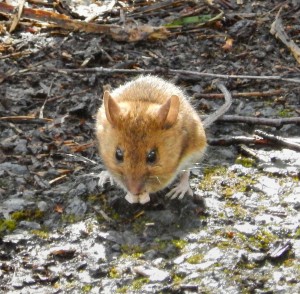
Category Archives: Nature Reserves
Scything the Anthill Meadow, Gunnersbury Triangle
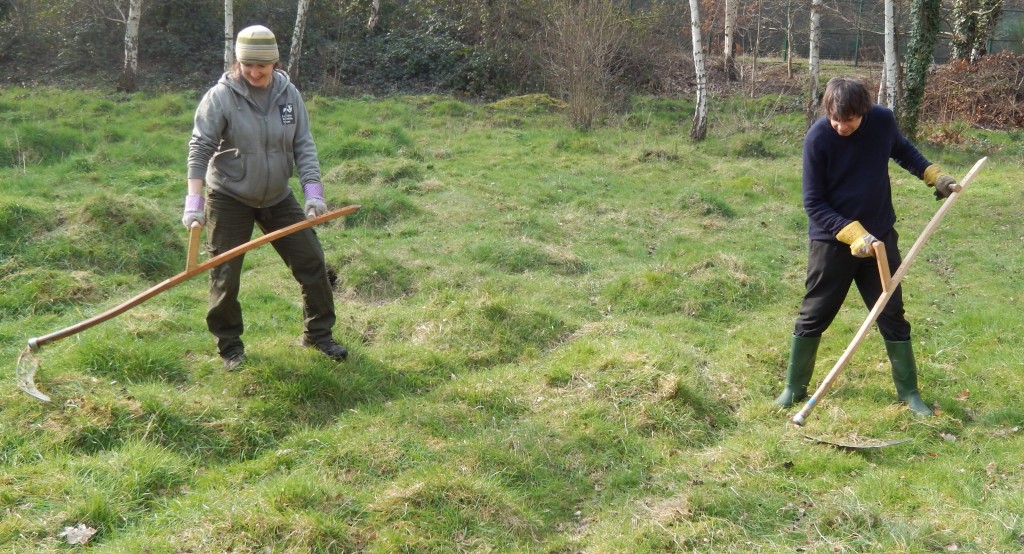
Spring, as in so many years, seems to be coming and going. Today, despite a gloomy forecast, the sun came out, coats came off, the Chiffchaffs started to sing, and we went happily to work in the sunshine. We fixed a new rail to mark off a Forest School area as “not a path”, despite appearances: we rigged it up with a hinge one end and a keeper – posh name for a pair of bits of batten screwed on to the post – to hold the rail the other end when it’s in the down position. We cleared up a vandalized loggery, using the stray bits of log and lots of cut ivy to block off an undesired path, and filled in the hole.
And then we all had a lesson in scything – you have to put the thing together to fit your height and arm length. The main pole is ingeniously not quite straight; the two handles each fit on with a bolt; the blade fits on with a lug and two grub screws in a metal housing. It sounds a bit fiddly and it takes a little time to adjust it, but when you have it exactly right, it’s a pleasure to use, and astonishingly light to swing. The blade needs to be sharpened every few minutes to keep it slicing effortlessly through grass, which contains silica (aka sand) and quickly blunts blades. But, well-maintained, the scythe is a remarkably efficient tool, and environmentally friendly. Contrary to expectations, it does not cause strain or backache, and people large and small can use it effectively. It’s trickier on bumpy ground covered in anthills. Five of us mowed the picnic meadow and the anthill meadow in an afternoon: it was no quicker (and a lot noisier) with the brushcutter. We disturbed a small frog or two, and accidentally scraped a small toad that was hiding in the long grass, but it wasn’t seriously hurt.
On the common I heard a Mistle Thrush calling, and a flock of Goldfinches. A party of Long-Tailed Tits visited the garden. Red and White Deadnettles are in bloom; Cow Parsley is coming into fresh leaf.
Winter Colour and Light at Thursley Common

On a gloriously sunny, still winter’s day, Thursley Common looked wonderful. There were few signs of wildlife – a Crow or two, some Stonechats hawking for flies from the tops of small bushes – but wide horizons, quiet, a sense of space and freedom.

Some dead pines displayed magnificent natural patterns, the product of bare wood drilled by Longhorn Beetle larvae and exposed to the elements.
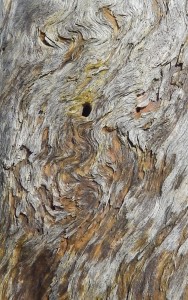
We visited Thursley’s thousand-year-old church – the north side of the choir has two small narrow Saxon windows, walled in for centuries. The church, of St Michael and All Angels, was wisely sited by the Saxons on a ridge of the Greensand, high and dry above the boggy moorland.
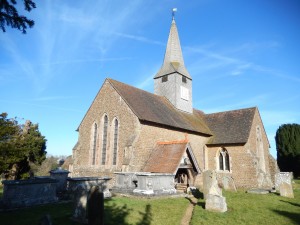
We enjoyed the modern glass doors engraved with a Tree of Life which turned out to be a Silver Birch. Among the animals praising God in the glasswork are a soaring, singing Woodlark; a perched Nightingale; a Lizard, a Purple Emperor butterfly, a Common Blue butterfly, and a selection of dragonflies: clearly the local fauna.
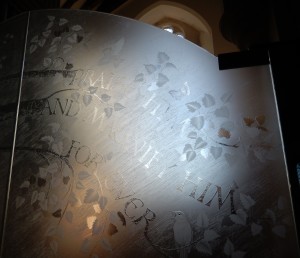
Quick, Fix Those Nestboxes! The Natural History of Nestbox Damage
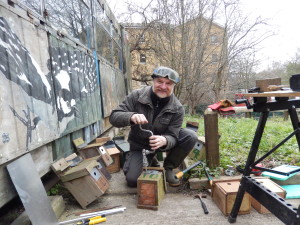
Quick! Spring is in the air, the Dunnocks are passionately singing their tuneless songs, the Great Tits are yelling Zi-Za-Zi-Za-Zi-Za endlessly, the Greenfinches are wheezing out their odd song (‘Zheee’), it’s time to fix those nestboxes. Most of those in the Gunnersbury Triangle had been “hammered” by Tits or Woodpeckers, or gnawed by squirrels. And a few had been rather roughly drilled by humans. So the warden decided that all of them should be given anti-squirrel plates; all, that is, except the Robin boxes, which have a wide rectangular opening in the front.
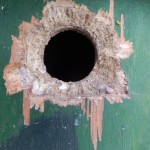
A few of the boxes seemed to have been attacked by squirrels. This one has what could be toothmarks and signs of extensive tearing of the wood outwards at a shallow angle, which looks like gnawing rather than hammering. It isn’t obvious why the basically herbivorous Grey Squirrel should do this.
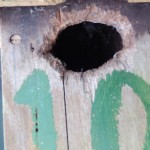
This box, on the other hand, seems to have been hammered at a sharp angle to the surface, whether by the Tits themselves (they certainly do this sometimes) or by Greater Spotted Woodpeckers preying on nests – although they mainly eat insects and seeds, they do take eggs and chicks when the opportunity arrives.
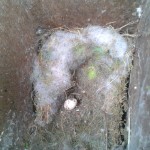
At least 4 of the nestboxes had substantial and reasonably fresh remnants of nests inside; this older one contained two long-addled tit eggs (just one shown here; it was 16 mm long) with a mixture of moss and down as insulation.
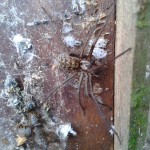
Finally, one very old nestbox, carefully engineered with beading around the hinged lid complete with little brass hooks, contained a Giant House Spider, Tegenaria, a lot of beetle pupae, and what could be Gypsy Moth pupae as well. The box was a messy tangle of thick sticky cobweb, and the spider was distinctly reluctant to leave, seeming to want to stand and fight off any intruder.
All in all, what might have seemed a mundane bit of metalwork turned out to be a day full of interesting natural history. (But the metalwork was fun, too.)

Animal Tracks in the Snow
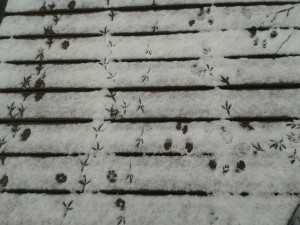
Today we woke to a snow-covered city, just a light dusting; and as often with snow, the weather was appreciably warmer than before the snow arrived.
Down at the nature reserve, the paths were empty of human footprints, but thickly sprinkled with animal tracks. Here some crows had walked to and fro across the path; there, a fox had jogged along the trail. But better was to come: the boardwalk across the pond was interlaced with tracks. On the left, a fox had gone the length of the boardwalk. In the centre, a crow had walked unsteadily along, the same way as me; and it, or another, had walked more rapidly back. On the right, more birds’ footprints: and the four-feet-together group of a squirrel, the smaller front prints clearly showing the marks of the sharp claws.
On a Birch branch above the anthill meadow, a Green Woodpecker hammered in search of food. Down by the ‘mangrove swamp’, a Jay screeched harshly, either for us or for a fox. Near the picnic meadow, a Sparrowhawk flew from its high perch, wheeled above the treetops, dived rapidly out of sight.
We carried tools and a ladder to visit the nestboxes and take down all that needed repairs. While I held the ladder, a party of four Long-Tailed Tits blew by, crossing from one Birch to the next one at a time. One of the boxes contained not just a mossy nest (like three others) but two old addled eggs, probably of Great Tit. While we struggled to prise off a somewhat too well attached box for maintenance, a Robin perched nearby, in hope of eating any grubs we might have disturbed. Several boxes had had their openings enlarged by much hammering by Blue Tits or Great Tits: nobody knows why they might do this, as it increases the threat to their nests from predators. We will make aluminium plates for the fronts of all the Tit boxes (the ones with circular holes): the Robin boxes just have a wide rectangular opening, which they definitely prefer. Inside one of the boxes was a mass of woodlice in the moss; another had a plump dead Noble False Widow Spider (Steatoda nobilis) inside.
Bullfinch! Winter Walk Hits Target
Winter has definitely set in. The spinach beet in my garden was all frozen, the air at -3 Celsius and the ground presumably rather colder under a clear night sky. Fearing it might all be lost, I picked some and went out to see what there might be today down at Wraysbury Lakes.
Almost the first thing I saw was a bulky little finch high in a waterside willow. It called ‘deu’ quite loudly, fidgeted about and flew before I could focus on it. Still, there was no doubt it was a Bullfinch: the call, its shape, its solitary habits, and its shyness all pointing the same way. It is never an easy bird to see, even where it is resident (it is regularly ringed at Wraysbury). Leafless trees and the rising energy of the coming breeding season provide one of the few opportunities to catch a glimpse of this less well known finch.
At first sight there seemed to be no birds out on the lake. Finding a small illicit patch cleared by a fisherman I set up the telescope and looked about. A Pochard or two; some Tufted Duck and Coot; a male Goldeneye… but the Smew and Goosander of a week or two ago were nowhere to be seen. The old truth is that you never know what you’ll see: but it’s often a delightful surprise, and almost always energizing to be out in nature.
I walked on and looked about again: some rather white ducks caught my eye in the distance. Two male Goldeneye, each with a female in tow. The males threw their heads forward a few times, pretended to preen; one threw his head back and forth, then lowered his head and stretched it out and in. His female swam after him, her head resting on her back as if she were asleep! But she was certainly watching the display, and swimming to keep up a few lengths behind.
A loud squawk betrayed a Heron; it flapped out of cover at the end of the lake and landed on the bank behind the ducks. A few Mallard panicked from the water below me; a Moorhen briefly took flight.
Away from the lake, a few Robin and Dunnock hopped in and out of the bushes. A solitary Fieldfare or two gave their chack-chack call from the hawthorns, watchful and flighty. Another Bullfinch calling, this time atop a bare hawthorn bush – or maybe the same bird, half a mile on – and again I couldn’t get binoculars on to it, despite my stealthiest movements: it had surely seen me at once, and just took a few seconds to decide when to flee.
A Kestrel hovered beyond the tall poplars: no Buzzards or Red Kites today, but really the Kestrel feels almost more special than them, its numbers declining across Britain.
A few Jackdaws, Carrion Crows and Wood Pigeons on the horses’ hill; some Fieldfares in the trees, with a single Redwing; a Stock Dove flying low.
A Bright Winter’s Walk in Richmond Park
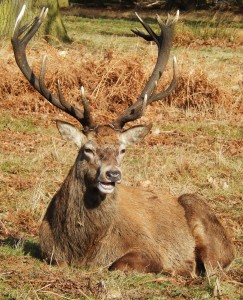
In Scotland, the male of the Red Deer is called simply a Stag, all other male deer (presumably Roe in that country) being known as Bucks. Down here, with Sika and other species about, it may be wise to name the species explicitly. There are signs up warning of the impending cull, so now may be the best time of year to see fine large stags resting quietly, the rut over.
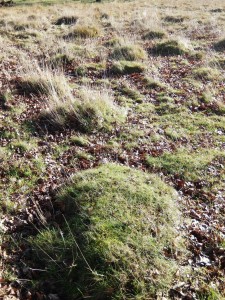
I was welcomed to the park by a flock of Jackdaws chattering in the trees. Down in the valley, last year’s grass stalks are whitening, the fine big anthills well outlined in the low winter sunlight.
A Stonechat was perched on a slender stalk, level with the tops of the grass; there cannot be much in the way of insect food to catch just now.
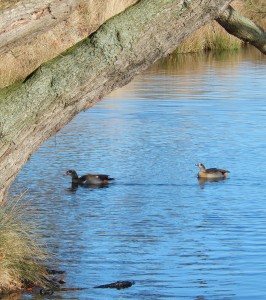
On the Pen Ponds, there were remarkably few waterfowl of any kind, but the lower pond had half-a-dozen Pochard. the males handsomely rufous-headed, a pair of Wigeon, the male with a conspicuous white wing-bar, and tucked in a corner under the willows a pair of Egyptian Geese, taking to the water and protesting with short dry honks when molested by a dog.
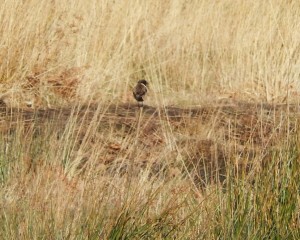
Walking back up the hill, a Kestrel hovered briefly, rested in a tree giving a good view of his spotted breast and back. Two herds of Red Deer, one at the base of the hill, one at the top, both with all ages and both sexes together, grazed silently. In the muddiest places, footprints of men, dogs and deer clustered together.
Showing Rupa Huq (Labour) Around a Nature Reserve

Having lobbied the sitting Member of Parliament for the local constituency, Angie Bray, a few weeks ago, I thought I’d invite the Labour candidate, Rupa Huq, and see what she thought about nature.
She came along to Gunnersbury Triangle, together with two of her supporters to take some pictures and video clips of the occasion. I did my best to fit what I wanted to say into short bursts – I don’t think I’ve ever been asked to do soundbites before, but perhaps it will come in handy when anyone asks what I think about nature and politics, or for that matter to put into a few words what my book is about. (It’s about how crazy the English are about nature, and why.)
We talked about why nature matters and the benefits it brings (votes, of course; human wellbeing in an age of e-gadgets; education; mental health; knowledge of climate change; the value of the wild gene pool… ), and I suggested some topics that it would be nice to have as party policy.
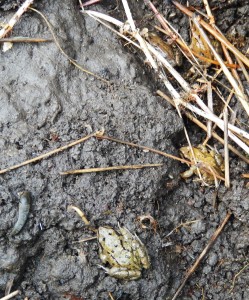
We walked around the reserve, saying a little about its history, its current uses (school visits, corporate bonding days, volunteering, talks, picnics, family visits, bug-hunting and pond-dipping, days out for the mentally handicapped). We saw the variety of habitats, enjoyed hearing the Robins singing even on a chilly day in January, and looked under a mat at the tiny frogs sheltering there. Rupa certainly left with a deeper understanding of what nature can do for people and why it matters; and of the possibilities that the Gunnersbury Triangle reserve, at least, has to offer for her constituents.
Wetland Centre: Winter Colours
2 January may not seem like a good time for mushrooms, but even now there are interesting and beautiful species to be seen. The Variable Oysterling, Crepidotus variabilis, is as its name implies able to take on different appearances. Here its small cap is distinctly fluffy with tufts of hyphae. The gills are fairly widely spaced, and extra ones are inserted (ok, intercalated) towards the edges.

The Osiers – long thin whippy poles of willows ideal for basket-making – are seen at their most colourful in midwinter.
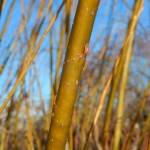
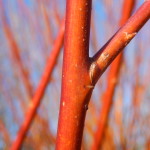
A flock of sixty or more grass-eating Wigeon, the males handsome with rufous heads complete with yellowish Mohican centre-stripe, grazed hungrily on the lush grass of the marsh. It must be a lot more welcoming than the frozen wastes of Scandinavia or Arctic Russia, where these birds have probably flown in from.
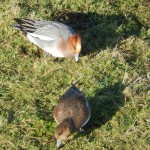
Hot as Hell? No, just the warmest Hallowe’en ever recorded
It was too sunny and warm to sit at a desk writing, so I took bicycle and binoculars and went along the Thames path to the Wetland Centre. Even in a T-shirt it was warm work, feeling more like an English July (ok, that’s not saying much) than the last day of November .
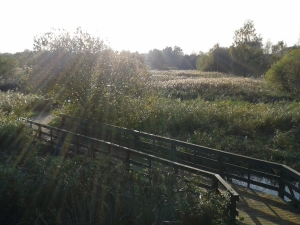
Inside the Centre I passed some diminutive witches and warlocks: they seemed to be sweating uncomfortably inside their costumes. I took a swig of water and cooled off in a hide; two rare migrants, Green Sandpipers, bobbed daintily at the end of one of the little islands, dwarfed by a Black-Headed Gull and a Moorhen, neither of them particularly large birds. Their habit is not unlike that of the Common Sandpiper, but they lack the white streak that rises in front of the wing. One of them took flight, its slender dark wings and white belly giving it something of the look of a rather large and clunky House Martin. It felt very odd to be watching autumn migrants on such a summery day.
Over at the wader scrape, a Little Egret strutted and once fluttered across the shallow water; it is an uncommon visitor here, though becoming more usual along the south coast marshes and estuaries.
A Green Woodpecker bounded over the grazing marsh in its distinctive undulating flight, its red cap and green body showing beautifully in the hot sunshine, with a loud laughing call in case anybody was in any doubt what it was.
A Cetti’s Warbler sang its bold short song, Chwit-i-pit-i-pit, Chwit-i-pit-i-pit, as usual invisible deep in a reedbed.
Out on the open water, numbers of winter ducks are (oddly, given the summery weather) building up; several Shovelers dabbled; some dozens of Wigeon grazed; a few Teal, the drakes in glorious colour, swam nimbly about with some Gadwall.
Even on the way home, I had no need of a pullover. The BBC weather report confirmed what everyone instinctively knew: it was the warmest 31st of October ever recorded in Britain, with an astonishing 23.6 Celsius in London. Of course, a cold front is forecast.
P.S. The next morning was grey and rainy, autumn on the way. Two large grey Mistle Thrushes flew overhead, rasping out their wintry calls, like a boy blowing over a comb covered in tracing paper.
P.P.S. Four days later, after a clear starry night, the sun rose over a chilly town on a fine November morning. It was winter.
